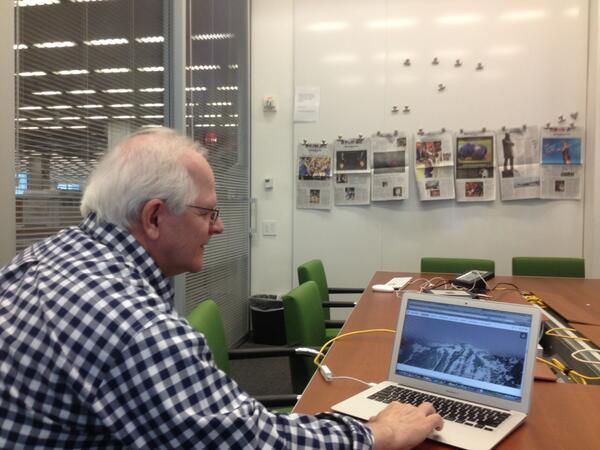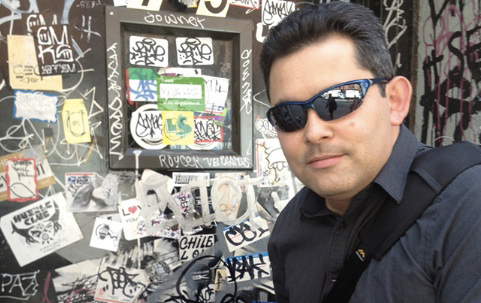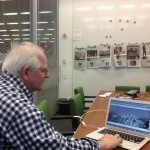Monthly Archives: May 2013

#JournovationTour NYC Stop 1: The New York Times – Snow Fall
May 20, 2013
This is part of a five-part report on my summer #JournovationTour of innovative digital journalism outfits and startups. The first stop on my tour was The New York Times.
In April at ISOJ, I heard a talk about Snow Fall by New York Times graphic artist Hannah Fairfield, and I wanted to learn more about how that groundbreaking package was put together so that we as journalism educators can guide students in that direction. She connected me with sports graphics editor Joe Ward (pictured above) and programmer Jacky Myint, who did all of the Jquery programming that made it possible.
There are a lot of things about Snow Fall that make it an example of great digital journalism, but what struck me most was two things: 1) the way in which the interactive elements pull you through and, in the style of a good novel, remove the fatigue that sets in with some long-form pieces; and 2) the degree of integration between the text and interactive elements. You can see examples of both in the chapter, The Descent Begins.
As you scroll down the page, you eventually get to a graphic of a mountain. As each skiier’s experience is described in the story, the person’s name is highlighted and you see the skiier’s path down the mountain.
Being semi-tech myself, I asked Jacky how this was accomplished without relying on something like Flash. It turns out that she once specialized in ActionScript, which she learned while earning a Masters in Fine Arts from Parsons, but as Flash went out of style she refocused on HTML, CSS and JQuery. Many of the scroll-based effects in Snow Fall are coded in Jquery using the Reel.js plugin. Commonly used in advertisements, the Reel.js plugin is described as an alternative to Flash and Java for creating 360-degree object movies, vistas and panoramas.
I know that’s a lot of geekspeak. For what it’s worth, I’ve asked Jacky if she can provide some easy tips for journalists who aren’t hard-core programmers who want to create their own scroll-based events and stories like this. She hasn’t answered yet so I take that as a sign that I’m oversimplifying the question. In other words, to do something like this you really need to work side by side with an experienced JQuery programmer.
And that gets to the much more interesting and actionable takeaway. The reason Snow Fall is an integrated experience is because not a single word was written before an interdisciplinary team was brought together, according to Joe Ward. “Designers were brought in very early,” Ward told me. “John Branch interviewed everyone in the story, came back and said ‘we have a lot of good stuff here.’ We got together and agreed, ‘Let’s not make it a story with lots of multimedia options. Let’s make it as seamless as possible.’ ”
And that’s exactly what they did.
But there’s another interesting back story to what made that decision easier. There used to be three departments, Graphics, Multimedia and Interactive News, with overlapping focus, and they sometimes competed for attention and resources. After one department disappeared due to the departure of a team member, the programmer was suddenly working side by side with a 3D animator and the traditional organizational barriers to collaboration disappeared.
Putting internal collaboration ahead of competition is the key lesson from Snow Fall. As Ward said, “No one person on the team could have done this story. It required all of us.”
So you hear that, digital news editors? Get your disparate teams together at the beginning of a story, not the end. Maybe even combine departments or, at the very least, create interdisciplinary teams that are ready to jump on a big story from day one. Otherwise you will end up with something like this whimsical example from the Time’s Aaron Pilhofer of how Snow Fall would have looked without an integrated approach. Or you’ll produce a nice, but not very interactive, video like the Times’ Punched Out.
Those are my takeaways from the New York Times visit. Thank you to Joe Ward and Jacky Myint for taking time out of their busy schedules to talk with me. I know our students at Newhouse would love to hear more!

Report from Dan Pacheco’s #JournovationTour in New York City
May 20, 2013
I just returned from a fast-paced tour of startups and journalists in New York City that are each shaking up the world of journalism in their own ways. I live-tweeted whenever possible using the hashtag #JournovationTour, and also took notes as I went along. This is a report from that trip.
Just for fun I wrote this in Spundge Pro, one of the startups I met along the way that I’m now evaluating for future use by students at the S.I Newhouse school. I just finished my first year as the Newhouse Chair of Journalism Innovation and will be co-teaching the class that feeds into the award-winning student-produced Newshouse site started by Jon Glass.
The five stops on my tour were:
- The New York Times, with the team that created Snow Fall.
- Marquee, a spunky little startup that powers the storytelling engine for Narrative.ly, now on Time’s 50 Best Websites list.
- Twitter, which recently hired Mark S. Luckie as an evangelist and trainer of journalists via Twitterfornews.
- Kickstarter, which as become a new way for journalists and media projects to get new projects and even companies funded.
- Spundge, a hybrid blog search, RSS reader, social media curator and publishing tool.
I realized going in that this was a broad and varied group of subjects, but that was also the point. I wanted to talk to a variety of people in organizations big and small to show students of journalism how their field is being shaped from all corners — not just the legacy organizations, but also from startups. And if my small sampling from New York City is any indication, there’s plenty of change, disruption and opportunity ahead for journalists.
My colleague, multimedia journalist and Professor Corey Takahashi, came long to some of the meetings and saw a couple common threads:
@pachecod Thinking back, there was a common theme to the tech cos: Each said they wanted to get out of the way of great content, creators.@pachecod Thinking back, there was a common theme to the tech cos: Each said they wanted to get out of the way of great content, creators.
— Corey Takahashi (@takalabtime)
May 17, 2013
I will agree with that, and also add that journalists in larger organizations are trying to get out of each others’ way, and to remove artificial barriers to collaboration.
Over the coming days I will be publishing each stop as its own article, then link them all together as one package. Start by reading my report from stop 1 at The New York Times.
Looking ahead, this is what I hope to be just the first part of a multi-city tour that I take through this summer, with other locations including Washington, D.C. and possibly Chicago. Want to meet me on the next leg of the tour? Let me know via @pachecod or @JournovationSU on Twitter or fill out our contact form.

